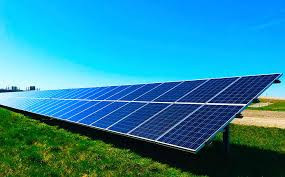views
The solar photovoltaic installations market has rapidly transformed from a niche energy segment into a central pillar of global energy systems. Driven by falling costs, technological innovations, and urgent climate goals, the scope of the solar PV market continues to expand, encompassing residential rooftops, commercial facilities, utility-scale solar farms, and hybrid energy systems. Governments, industries, and consumers alike are turning to solar PV as a reliable, scalable, and clean solution to meet rising energy demands while reducing carbon footprints. This article explores the broad and evolving scope of the solar PV installations market across applications, geographies, technologies, and policy frameworks.

Expanding Applications Across Energy Sectors
The scope of solar PV installations now covers a wide spectrum of applications—from powering homes and businesses to supplementing grid capacity at the national level. The residential segment remains a key driver, particularly in countries where electricity prices are high or where incentives such as net metering make solar systems financially attractive for homeowners.
In the commercial sector, solar installations are increasingly being used to reduce energy bills and meet sustainability targets. Retail chains, warehouses, data centers, and office complexes are installing solar panels to achieve energy independence and environmental compliance.
Utility-scale projects, which contribute the largest share of capacity additions, are powering cities and industries with large volumes of electricity. These massive solar farms are often built through public-private partnerships and are critical to national renewable energy roadmaps.
Off-grid and hybrid systems represent a growing niche, especially in developing countries and remote areas. In these regions, solar PV provides an affordable alternative to diesel generators and supports essential services like healthcare, water pumping, and telecommunications.
Geographic Expansion of Market Scope
The global reach of the solar PV installations market is steadily widening. While early adoption was concentrated in developed nations like Germany, the U.S., and Japan, emerging economies have now become the fastest-growing markets.
China continues to lead in terms of installed capacity, supported by massive government programs, manufacturing dominance, and favorable tariffs. India, with its ambitious solar mission, is rapidly expanding its solar infrastructure through utility-scale parks and distributed generation.
Southeast Asia, the Middle East, Latin America, and parts of Africa are also emerging as promising markets due to rising electricity demand, high solar irradiation levels, and government support. Countries like Vietnam, Brazil, and Egypt are launching large-scale solar projects and revising regulatory frameworks to attract investment.
Technological Diversification Enhancing Market Reach
Another dimension of the solar PV market’s scope is its technological diversity. Innovations in solar panel design, efficiency, and installation methods are making the technology more accessible and adaptable to different environments.
Monocrystalline and polycrystalline silicon panels remain dominant, but advanced technologies like bifacial panels, PERC (Passivated Emitter and Rear Cell), thin-film modules, and perovskite solar cells are enhancing performance and lowering costs. Floating solar farms, building-integrated photovoltaics (BIPV), and agrivoltaics (solar on farmland) are extending the market’s reach into previously untapped areas.
Energy storage, particularly lithium-ion batteries, is increasingly being paired with solar PV systems to ensure reliability and enable off-grid applications. Smart inverters, remote monitoring systems, and AI-driven analytics are making solar PV systems more intelligent, efficient, and user-friendly.
Integration with Sustainable Development Goals
The scope of solar PV installations aligns strongly with global sustainability and climate goals. Solar PV plays a central role in decarbonizing power systems and achieving targets under international agreements like the Paris Accord. National governments are including solar energy in their long-term strategies for net-zero emissions, energy security, and economic growth.
Additionally, solar PV supports several Sustainable Development Goals (SDGs), including affordable and clean energy (SDG 7), climate action (SDG 13), and industry innovation (SDG 9). Its use in community development, education, and healthcare in underserved areas underscores its broader societal benefits.
Government Policies and Incentives Expanding Market Opportunities
Policy support remains a key enabler in broadening the scope of solar PV installations. Many countries offer a mix of incentives including tax credits, subsidies, feed-in tariffs, renewable portfolio standards, and net metering policies to stimulate demand.
For instance, solar mandates for new buildings, simplified permitting processes, and low-interest loans are driving residential installations. Large-scale auctions and power purchase agreements (PPAs) are facilitating the expansion of utility-scale solar projects.
Public-private collaborations, multilateral funding, and green bonds are also mobilizing investments in solar infrastructure, especially in capital-intensive markets.
Emerging Business Models Broadening Accessibility
As the market matures, innovative business models are further expanding its scope. Third-party ownership, leasing arrangements, and energy-as-a-service platforms are lowering entry barriers for consumers and businesses. Companies are also offering bundled services that include installation, maintenance, monitoring, and insurance.
Crowdfunding and cooperative solar initiatives are enabling community participation in the renewable energy transition. Pay-as-you-go models, especially in Africa and South Asia, are making solar PV accessible to low-income households with no upfront cost.
These flexible, consumer-friendly models are helping diversify customer segments and accelerate adoption across income groups.
Conclusion
The solar photovoltaic installations market is entering a new era of opportunity, with a rapidly widening scope that touches virtually every corner of the globe and every sector of the economy. From powering remote villages to enabling smart cities, solar PV is playing a central role in reshaping the global energy landscape.
As technology advances, policies evolve, and awareness grows, the market’s scope will continue to expand—unlocking new avenues for sustainable growth, energy equity, and climate resilience. For governments, businesses, and communities alike, solar energy offers a powerful path toward a cleaner, more inclusive energy future.



Comments
0 comment